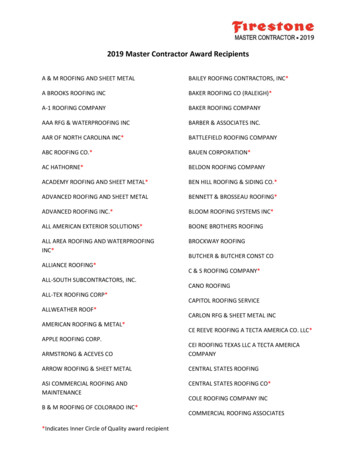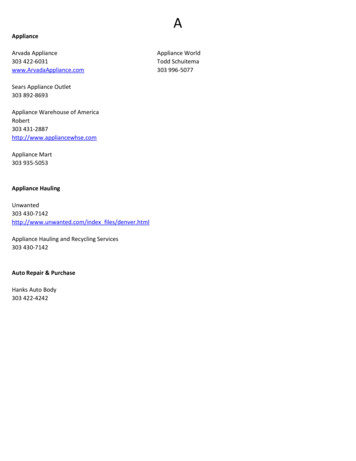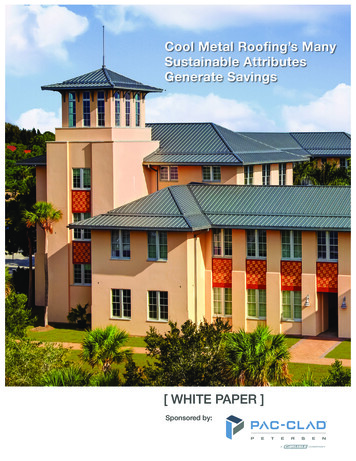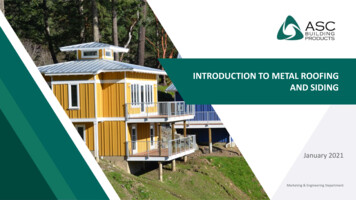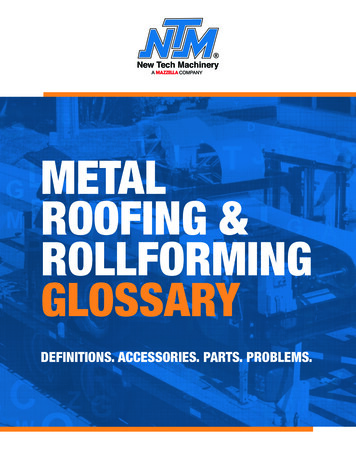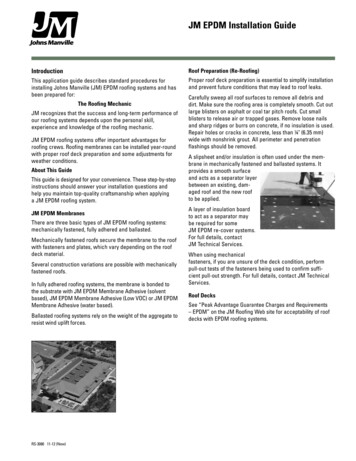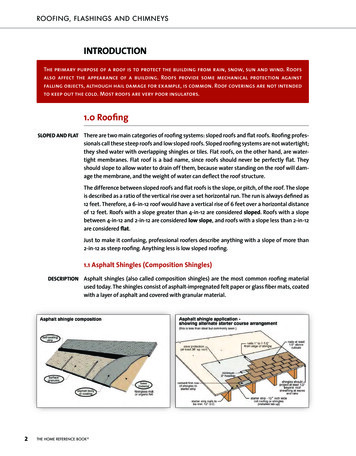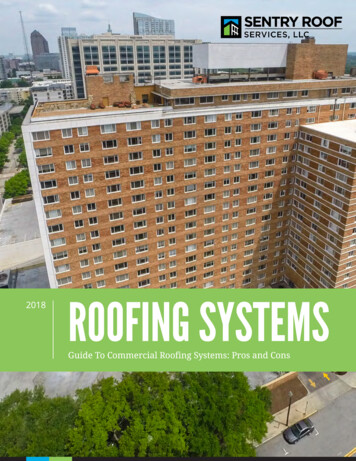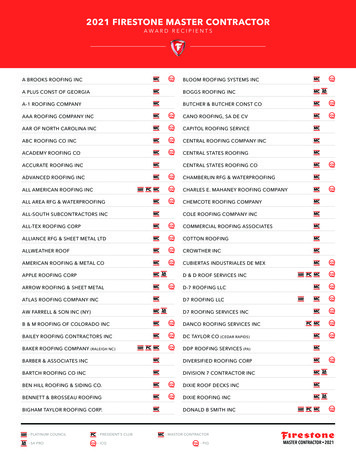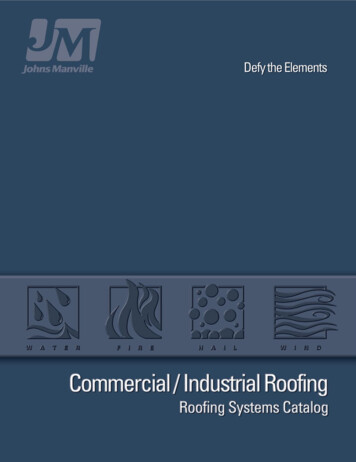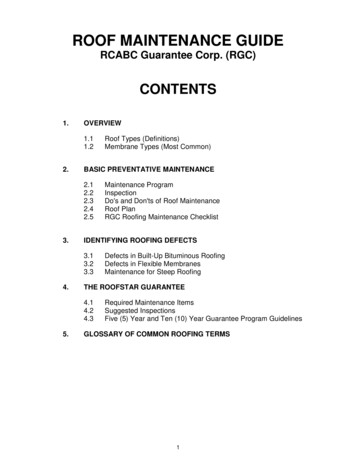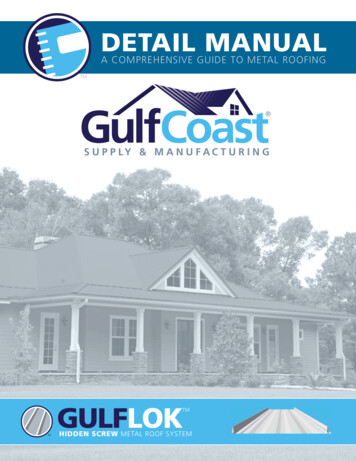
Transcription
DETAIL MANUALA COMPREHENSIVE GUIDE TO METAL ROOFINGGULFLOKTMHIDDEN SCREW METAL ROOF SYSTEM
GULFLOK TM DETAIL MANUALAKA STANDING-SEAM PANELGulf Coast Standing SeamRoofing Panelsmost popular and economical standing seampanel style, features approximately one-inchhigh ribs and a net panel coverage of either 12 or16 inches. The “nail strip” and screws thatattach each panel are in turn covered by eachsubsequent panel as each overlapping panellocks in place over the previous one (see Fig. 7).The Gulf Seam panel also uses a locking ribfeature, but offers a 1¾-inch rib that attacheswith specially designed clips. It comes in widthsof 14, 16, and 18 inches.Both styles of standing seam panel areavailable with either striations or ribs, either ofwhich affords an attractive appearance accordingto the tastes of the customer. Consult Figure 2for the profile you would like for your standingseam roof.roofing, and with the added advantage of on-sitepanel manufacture (our most common arrangement for sale), we believe our product to be thebest and most affordable of its kind in northcentral Florida.Gulf Coast standing seam roofing comesin two styles, and each style is available in eitherof two distinct profile patterns. Gulf Lok, ato Live Oakand I-75to Perry,Tallahasseeand I-10BranfordOrlandoto Lake Cityand I-7534919 Cross 351CityGulf ofMexicoTrentonsFig. 2 The Gulf Seam panel (top) features 1¾” ribs andmounts with special clips; the 1” high Gulf Lok “nail-strip”panel (bottom) is our most popular standing seam panel.The “rib” profile is shown on the upper panel, the“striation” profile on the lower.Fig. 1 The Gulf Coast facilityleSince 2004, Gulf Coast Supply andManufacturing has been happy to offer theaddition of two styles of Standing Seam roofingto its other popular lines of roofing panels.Standing seam, the Cadillac of roofing panelsystems, offers the advantage of a completelyhidden fastening system, eliminating the worrythat sometimes accompanies the exposed fasteners of other styles of roofing.* Formed from 24gauge AZ-50 Galvalume coated steel, coatedwith the best paint system available in any14mi351HorseshoeBeachOldTown 1926toGainesvilleChieflandto Ocalaon14 miles southofCross CityFig. 3 Gulf Coast Supply is located between Cross Cityand Horseshoe Beach.*Any roofing system with exposed fasteners can be applied leak-proof if installed properly. We recommend employingonly proven and reputable roofing installers.1(888) 393-0335ÊUÊ 8Ê ÎxÓ Ê{ n ÇnxÓÊUÊÜÜÜ Õ v ÃÌ-Õ«« Þ V 2
GULFLOK TM DETAIL MANUALAKA STANDING-SEAM PANELGulf Coast standing seam roofing is available in either 25-year acrylic-coated Galvalume or anyof over 20 colors, comprising of 40-yearlow gloss .7 to .9 mil full strength70% Kynar 500/Hylar5000 fluorocarbon coatings over aurethane primer of .2 to .3 mil on theFig. 3 Gulf Seam panels,finish side, with primer and washcoat onshowing lap detail andthe reverse side. Metallic coatings areplacement of UL-90 clips.also available and carry the same 40-yearwarranty. We manufacture both stock and customtrims and flashings, and provide screws and other accessories specific to standing seam installation (see back page).Gulf Coast Supply recommends the convenience of on-site manufacturing withour portable roll-former. Delivery or customer pick-up of crated panels is also available at our facility near Horseshoe Beach, Florida (crating and delivery charges apply).Fig. 4 Gulf Lok panels,showing lap detail andnail strip.While there are many possible trim and attachment solutions in the application of standing seamroofing, the Gulf Coast sales team endorses the methods shown in this manual as being among the bestrecommended in the standing seam industry. We are glad to offer our advice, suggestions, or commentsto those who prefer variations of these procedures. We cannot endorse methods that are unfamiliar tothe industry, however, and can only support those which meet the standards of engineering that havebeen passed in controlled tests, or have been shown reliable by experienced contractors.1(888) 393-0335ÊUÊ 8Ê ÎxÓ Ê{ n ÇnxÓÊUÊÜÜÜ Õ v ÃÌ-Õ«« Þ V 3
GULFLOK TM DETAIL MANUALAKA STANDING-SEAM PANELStanding Seam TrimEndwallflashing(p. 14)Valley(p. 15)Gable trim(p. 13)Ridge cap(p. 10)Sidewallflashing(p. 14)Eave drip(p. 12)Roll Lite DoorTransitionFlashing(p.15)CAUTION! clean allmetal shavings andparticles off of roof toavoid unsightly rust stainsFig. 5 Roofing trims and flashings are named by the locationor function of that particular piece on the building.1(888) 393-0335ÊUÊ 8Ê ÎxÓ Ê{ n ÇnxÓÊUÊÜÜÜ Õ v ÃÌ-Õ«« Þ V 4
GULFLOK TM DETAIL MANUALAKA STANDING-SEAM PANELInstallation of PanelsRoof PitchFlorida Building Code requires a minimum pitch of 2/12 for the 1¾" Gulf Seam, and 3/12pitch for the 1" Gulf Lok, to ensure proper water drainage. This means that the minimum roof sloperequired for all panels is either 2 or 3 inches of rise per foot, depending on which profile you choose.Consult our representative for recommendations for your particular roof pitch, and about roofingoptions if you have less than either of these minimums.Ordering and Applying TrimThe most common flashing for standing seam roofing is the ridge cap, which is used at the peakof a roof where two opposing roof slopes join, and attaches to the roof with z-flashing. Other flashingsthat attach with z-flashing include transition flashing (which also requires panel starter), end wall andsidewall flashings. Panel starter is required to attach panels over valleys, Eave flashings includegable flashing, which runs up the sloped ends of the roof, and eave drip, which trims out the lowerends of the panels and provides a surface for the attachment of the lower end of the panel. Both gableflashing and eave drip are often applied above fascia trim, and may be attached with either surfacescrews or hidden eave cleats. For details about the application of each type of trim, see the detailsprovided on pgs. 10-15.Roof PreparationOil-canning is a wave-like, rippled appearance extending up the length of the panel after it hasbeen installed on the roof. Any irregularities in the roof, including uneven plywood joints, warpedplywood, uneven trusses, poor application of underlayment, the use of button caps with felt paper, etc.,can promote oil-canning. Care should be taken to provide a flat, uniform surface on which to attachthe panels. See page 8 for more details.Roof pitch must be given when ordering ridge caps, endwalls, valleys, andeave drip. When a steeper roof slope meets a lesser slope, both slopesshould be mentioned when ordering transition flashing.Dormer detailFig. 6 Most of the basicstanding seam trimsare used ondormers. Thebottom corners ofthe dormer aresimilar to theplacement ofsidewall andendwall flashings onchimneys. All butvalleys and eave driprequire z-flashing;valleys requirepanel starter, andeave drip may bescrewed orfastened with eavecleats.Ridge cap(p. 10)Gable trim(p. 13)Endwallflashing(p. 14)1(888) 393-0335ÊUÊ 8Ê ÎxÓ Ê{ n ÇnxÓÊUÊÜÜÜ Õ v ÃÌ-Õ«« Þ V Valley(p. 15)Eave drip(p. 12)Sidewallflashing(p. 14)5
GULFLOK TM DETAIL MANUALAKA STANDING-SEAM PANELGeneral Principles of a TypicalInstallation—Hidden FastenerSystemFig. 7 Each panel should beinstalled over the extendedeave drip, pressed down andattached with the appropriatefasteners,and eave hemsfinished before installingthe next panel.direction of installationExcept for only a few differences, the high-rib Gulf Seam panels and the low-rib Gulf Lok panels areinstalled in the same general fashion. Where pancake screws are applied to the “nailstrip” of the GulfLok panel, special clips (that require 2 screws each) are used for the Gulf Seam panel.When used, extended eave drip should be installed first along the drip edge of the roof. The lowerend of each panel is then trimmed and the hem pre-bent before installation (see p. 12). The starter panelis laid out with the overlap side against an eave or wall and the hem pulled up tight and then compressedaround the eave drip. The “nailstrip” (or clips, in the case of Gulf Seam) is screwed off completely withpancake screws before the next panel is installed. Care should be taken that the starter panel is squarewith the roof, since the first panel determines the lay of all that follow it.The pre-bent eave end of the next panel is then pulled tight against the eave drip and pressed or“walked” down over the first panel, its nailstrip secured, and the next panel applied, and so on. Eachpanel is always screwed off and the hem finished before installing the next. The unfastened lengthagainst the gable or wall is secured (then or later) with z-flashing and either gable rakes (on the gableeave) or sidewalls (against a wall).Ordering Roof Panels and ScrewsCare should be taken to order panels of the correct length to avoid having to make correctivemeasures after purchase. Panel lengths should fall 2 to 3 inches short of the ridge when a vented ridge isdesired, and should ordered to extend 2½ inches past the eave when being attached to extented eave drip(see p. 9 or, if being used with gutters, p. 6). The Gulf Coast sales personnel are ready to assistcustomers with information specific to their particular roof.Special, flat-headed screws called pancake screws are used to attach either nail strip panels or the clips that secure the locking panels. Woodgrip pancakes are used when going into wood decking, orself-drilling pancakes for going into metal purlins. The same screws also secure attachment flashingslike z-flashing, panel starter, and eave cleats. 1/8-inch stainless rivets are recommended for attachingridge caps, endwall and sidewallflashings, transition flashings, and anyOn Gulf Lok (nailstrip) panels, screws should beother flashings that attach to z-flashing. centered in slot and should not be tightenedSee page 6 for more information oncompletely to allow for panel expansion.screw spacing and ordering.1(888) 393-0335ÊUÊ 8Ê ÎxÓ Ê{ n ÇnxÓÊUÊÜÜÜ Õ v ÃÌ-Õ«« Þ V 6
GULFLOK TM DETAIL MANUALAKA STANDING-SEAM PANELRidgeTransitionallow 2" to 6" setback*but add 1" tofold back for hem2" to6"allow 2" betweenpeak and panelUpper section1"hemEaveallow 2½" extra:1½" for overhang, plus1" to fold back as hem1½" overhang1" hemLower sectionSince allowance must be made in the hiddenfastener system for hemming panels that attach to*4" to 11" for 1¾" Gulf Seamextended eave drip (see p. 12), these panels shouldFig. 8 Allowances must be made when orderingbe ordered approximately 2½" longer than thepanels to allow for hemming of panels, overhang,ridge venting, and errors.substrate decking to allow panel length for the 1½"nose on extended eave drip plus the 1" hem.Likewise, panels ending in valleys should beordered 1" longer for hemming, but with allowance made for a 3 or 4" passageway between the paneland the valley diverter to allow for the flow of water (subtract 3 or 4").Where the deck makes a transition from a higher to lesser pitch, lower panels should be orderedfrom the transition point downward allowing for eave drip (as above), and upper panels must allow for asetback away from the transition point depending upon the roof pitch, the less the difference in pitch, thegreater the setback, and the more the need for a longer length on the lower side of the transition flashing(see p. 15 for details).The general principles of attaching the upper and lower edges of standing seam roofing are mostthoroughly covered in the sections on “Eave drip”(p. 12) and “Ridge caps” (p. 10).Trimming and Cutting Steel PanelsThe best devices for cutting steel panels across the profile are circular saws, nibblers, andvarious shear attachments for drills. Hand operated snips also work. Nibblers, and especiallyCarborundum blades on electric saws, however, do have a tendency to either leave hot metal particlesthat can burn paint surfaces or leave rust marks on panels and trim. The same is true of any filings lefton the roof caused by the application of screws. Care should be taken to brush all such particles fromroof surfaces immediately after application.To cut panels lengthwise: Note carefully where the panel is to be cut, and, using a straightedge,score deeply down the length of the panel with a sharp-pointed utility knife. Folding the panel along thescore mark, and bending back again if necessary, should produce a clean break in the panel.Keep Materials Dry!Paint and finishes of Gulf Coast panels and trim are designed to withstand severe rain and wetweather conditions. Neither paint, galvanized, or Galvalume finishes, however, are designed to be incontinuous contact with water for long periods of time. Damage will result if uninstalled panels or trimare allowed to remain wet in storage. Be sure to store material that will not be installed immediately ina dry location. Wet material should be air-dried and re-stacked if installation is not planned right away.1(888) 393-0335ÊUÊ 8Ê ÎxÓ Ê{ n ÇnxÓÊUÊÜÜÜ Õ v ÃÌ-Õ«« Þ V 7
GULFLOK TM DETAIL MANUALHow to Figure and Apply ScrewsCleats, and Other AccessoriesGulfLokz-flasea hingvcleeapa tsnesta lrtriv eretspasc ncare kehe wsmto m iol ngbutylca tapeul(tukbes)AKA STANDING-SEAM PANELRidge cap216302ExtendedStanding seam roofing is particularly noted8 yes1Eave dripfor its use of hidden fasteners. Pancake screws are18 1210'Gable trim 1used because they are strong and yet have a lowprofile that does not interfere with panel and trim8 1210'Sidewall 1installation. For nailstrip panels, one pancake screw8 1510' 1Endwall 1is required every 10¼ inches, (every other slot),Transition 118 23 yes 10' 1which comes out to 86 screws per 100 sq. ft of roofflashingfor 16 inch panels. This makes the number of12 yes 20'2Valleyscrews necessary equal to the linear footage of theFig. 9 Above chart is for a typical Gulf Lok roof with allorder times 1.15:hiddenfasteners. For each type of trim on the left, the# screws linear ft of panels x 1.15amount of the necessary accessory at the top of the chart isSince other panel widths make the total for the shown in each box. While caulk will work where butylentire roof to vary, please confirm all estimates with sealant is shown, we recommend butyl sealant on fullyour Gulf Coast representative when you place your lengths of trim because it is economical and easy to apply.order.For Gulf Seam panels, one clip is applied every 2 feet, with 2 pancake screws holding each clip. This makes 38clips and 75 screws per square of 16-inch roofing.For solid decking, at least ½-inch structural plywood (5/8" for Metro-Dade new construction and for any highPoliciesAll standing seam trim and panels are manufactured from 24-gauge prime coil stock. Trim is returnable as long asit is deemed as being in good, clean, resalable condition by our company’s representative, free from scratches, mars,and other damage. The same general principle applies also to the return of accessories such as screws, boots, closures,etc. Trim that is custom-made is not returnable, and is considered the property of the customer once it has been made,whether paid for or not. See below for details.Delivery policy Delivery charges apply to all orders where delivery is requested, as well as crating charges whencrating is necessary. Please consult your Gulf Coast sales department for details.Sales tax All orders picked up at Gulf Coast Supply, and all orders delivered within the state of Florida, are subject tostate sales tax. Tax exemptions should be verified prior to delivery or customer pickup. Orders delivered out-ofstate are tax exempt.Warrantied productsPainted standing seam panels come with a 40-year coil manufacturer’s warranty, and unpainted Galvalume comes with a 25-year warranty. All trim is manufactured from the best grade of stock in theparticular color ordered.Indemnity All prices and designs are subject to change without noticeDisclaimer While we have made every attempt at accuracy in this manual, we are not responsible for typographic,printing, or technical errors.Oil Canning—a repeating, wave-like appearance in the length of the panel—is a common and often unavoidablephenomenon in all profiles of standing seam roofing due to the large, flat areas within the panel. It is therefore not adefect, nor a cause for rejection. Since ordering panels without striations greatly increases the risk of oil canning,striated panels are recommended for standing seam.Return policy All panel orders and special order (non-stock) trim are considered the property of the customer andnon-returnable once they are manufactured. Only trim made from our normally stocked colors may be returnedfor a refund providing it is returned in a clean, resalable condition. Restocking charges apply.1(888) 393-0335ÊUÊ 8Ê ÎxÓ Ê{ n ÇnxÓÊUÊÜÜÜ Õ v ÃÌ-Õ«« Þ V 8
GULFLOK TM DETAIL MANUALAKA STANDING-SEAM PANELFastening Schedule for Various Wind Speeds110 MPHWind Speed Zone120 MPH130 MPH140 MPHRoofZoneFastenerType ASubstrateOn CenterSpacingOn CenterSpacingOn CenterSpacingOn CenterSpacingZone 1#10-12x1 "CDX*10¼"10¼"10¼"10¼"Zone 2#10-12x1 "CDX*10¼"10¼"10¼"5 1 8"Zone 3#10-12x1 "CDX*10¼"10¼"10¼"5 1 8"* 15 32" CDXGulf Seam 24 ga.Fastener Spacing(clip spacing)19Gulf Lok 24 ga.Fastener Spacing(between screws)" CDX32110 MPHWind Speed Zone120 MPH130 MPH140 MPHOn CenterSpacingOn CenterSpacingOn CenterSpacingRoofZoneFastenerType ASubstrateOn CenterSpacingZone 1#10-12x1 "CDX*24"24"24"24"Zone 2#10-12x1 "CDX*24"24"24"12"Zone 3#10-12x1 "CDX*24"24"24"12"* 15 32" CDXZone 210¼" is every other slot19" CDX32aEaveRidgeZone 1Zone 3itemaaGableFig. 23 Note: Dimension a is defined as 10% of theminimum width of the building, or 40% of the mean heightof the roof, whichever is smaller; however, a cannot beless than either 4% of the minimum width of the building,or 3 feet.EaveSummary of Stock Trims and Flashingsspecial order informationRidge caps (RC-7)State roof pitch when ordering. Also available in larger widths.Attached with Z-flashing (2 per ridge cap) and rivets.Eave drip (ED-7, ED-8) Specify roof pitch when ordering. ED-7 extended eave driprecommended (cleats necessary for hidden fastener installation.) Specialtools required to attach panels. ED-8 requires exposed screws on panel.Gable flashings (EF-7, Screwless and step rakes available. Cleats necessary for screwlessEF-8, EF-9, EF-10) rakes. Use butyl sealant between step rake and panel.Valleys (PV-1)Specify pitch when ordering. Panel starter necessary for hidden screwapplication. Butyl sealant used under starter.Sidewall (SW-7. SW-8, SW-7 & SW-9 (Gulf Seam) require Z-flashing and rivets. Use butylSW-9, SW-10) sealant between SW-8 & SW-10 step sidewall flashings and panel.Endwall (EW-7)Specify pitch when ordering. Attaches with Z-flashing and rivets.Transition flashingSpecify pitches of both roof sections. Attaches with Z-flashing and rivets(lower) and panel starter with pancake screws (upper).1(888) 393-0335ÊUÊ 8Ê ÎxÓ Ê{ n ÇnxÓÊUÊÜÜÜ Õ v ÃÌ-Õ«« Þ V 9
GULFLOK TM DETAIL MANUALAKA STANDING-SEAM PANELRidge CapRidge capThe Ridge Cap is used topre-cutz-flashingseal the upper point at whichtwo slopes meet. This can beboth along the ridge of theroof as well as the coveringfor a hip, as well as on thenotchedz-flashingridge of dormers.Attachment to the roof is Caulkm o s t g e n e r a l l yaccomplished through theuse of z-flashing.Zflashings are either notchedor cut to length (to fit Fig. 10 To attach ridge caps, z-flashings are either notched (left) or cut intobetween panel ribs) and pieces (right) and mounted with screws at the upper ends of the panels. Caulk isapplied on the bottom side and around the panel ribs to seal the ridge against rain.attached with screws to the The mounted ridge cap is attached to the z-flashing with rivets.roof through the panels.Ridge caps are in turn attached with rivets to the z-flashing. Whether the z-flashing is notched or cut tolength, gaps between it and the panels should be kept to a minimum (no more than ¼ inch) since the gap willbe sealed with caulk. Z-flashing must be sealed both beneath and where it butts against the panel ribs with Solar Seal 900caulk or equivalent. Thus sealed, z-flashing forms a water-proof barrier to protect the roof peak from leaksfrom blowing rain. When used on a hip roof, z-flashing is cut or notched at whatever widths are appropriatefor the pitch and cut of the aneldeckFig. 11 Ridge caps can be installed as vented (using panel starter and vent material) or sealed (usingz-flashing), as shown also in Fig. 12.1(888) 393-0335ÊUÊ 8Ê ÎxÓ Ê{ n ÇnxÓÊUÊÜÜÜ Õ v ÃÌ-Õ«« Þ V 10
GULFLOK TM DETAIL MANUALAKA STANDING-SEAM PANELFig. 12 3-dimentional viewof ridge showing ProfileVent clips and Profile Ventinstalled on left, and zclosure installed on right.See opposite page for clipattachment details.AttachmentflashingsWhen attic ventilation is desired, thedecking must be cut at the ridge to let outhot air. Vent clips are used to hold the ventmaterial in place instead of z-flashing, andare applied one per panel. Closure materiallays down as a continuous run over the ribsand is sandwiched between the panels andthe ridge caps.Vent material is either a sponge-like or afibrous material that prevents insects, winddriven rain, and leaves and debris fromentering the attic, while at the same timeallowing the release of hot air out of theattic. Installation may require caulk to holdthe material in place. If non-continuousmaterial is used, it must be cut to the panelwidth before installation.eave cleatz-flashing2"panel starterEave cleats allow thehidden fastener system towork with eave drip and gablerakes. The factory-hemmed edgeof the rake or eave drip fits around the “kick-out” of the cleat,which is attached to the fascia baord with pancake screws.Fig. 13 Pipe Boots provide a watertight seal around roof vents andcome in a variety of sizes. They sealwith caulk under the base andaround the pipe. To assure watertightness of the roof, avoid installingover panel ribs.Panel starter is used to attach the lower ends of hemmedpanels over trim above the eave, as with valleys and transitionflashing. It is attached with pancake screws and sealed beneath with butyl sealant.Z-flashing is the basis for attaching five basic trims to the roof. When attaching ridge caps, transitionflashing, and endwalls, z-flashing must be notched or cut to fit between panel ribs. when attaching gabletrim and sidewalls, the z-flashing is not cut, but is mounted parallel to the ribs. Z-flashing must beattached with screws and, to prevent leaks, with butyl tape (or equivalent) underneath. Order ZF-7 forGulf Lok, and EF-9 for Gulf Seam. For specifics, see each type of trim being attached.1(888) 393-0335ÊUÊ 8Ê ÎxÓ Ê{ n ÇnxÓÊUÊÜÜÜ Õ v ÃÌ-Õ«« Þ V 11
GULFLOK TM DETAIL MANUALAKA STANDING-SEAM PANELEave Drip & FasciaFascia and extended eave drip provide aprotective covering for the fascia boards andedges of roof decking at the drip eave of thebuilding. Unlike conventional exposed fastenerroofing, eave drip on the standing seam roof alsoacts as an anchoring device for the lower edgesof the panels, allowing a continuation of thehidden fastener system all the way down to thesoffit. Fascia are overlapped by eave cleats,which approximately line up with the roof edgeof the decking, and are held in place by pancakescrews. The extended eave drip has an open hemthat hooks on to the cleat at its lower end, and isscrewed to the decking on the roof side. Panelsare trimmed in a specific manner (see diagrambelow), bent with a hemming tool, and crimpedaround the extended eave drip, securing thelower end of the panel. Screws applied to theFig. 14 Layered view of eave, showing fascia (1), cleat (2),extended eave drip (3), and panel (4). Note how the eave dripfits around the cleat, and how the cut panel (which is bent onsite by the installer) fits around the “nose” of the eave drip (inactual use, extended eave drip must match color of panel).“nail strip” of the Gulf Lok panel (or cleats and screws in the case ofGulf Seam panels) secure the rest of the length of the panel. Thesame hemming procedure applies to valleys and transitionflashing, although these are attached to roof cleatsinstead of the “nose” of the extended eave drip.See valleys and transition flashing (p. 15)for specific details.When ordering care must betaken to specify the correct pitch ofeave drip to avoid eitherunnecessary effort inapplying the trim21Fig. 15 Toapply panelsover extendedeave drip, thepanel is firsttrimmed, thenfolded with ahemming tool, andfinally compressed around the eavedrip with broad-nosed pliers.1(888) 393-0335ÊUÊ 8Ê ÎxÓ Ê{ n ÇnxÓÊUÊÜÜÜ Õ v ÃÌ-Õ«« Þ V panel rib312
GULFLOK TM DETAIL MANUALAKA STANDING-SEAM vecleat2"extendedeave drip½"ED-7extended eave e drip½"Exposedpanel screwsED-8too steep). If more than one pitch is involved, specifythe number of each pitch (eave drip comes in 10-footlengths). Order 90 degree eave drip for square-cuteaves.While the hidden fastener system calls for eavecleats, exposed screws are a simpler and easier-to-installoption for eave drip. Surface screws are simply installedat intervals along the face of the trim. Finally, while theremainder of the roof uses hidden fasteners, someinstallers elect to use screws in the conventional fashionalong the eave only of the building. These simplifyingprocedures both reduce cost and allow faster applicationof the roofing.(conventional eave drip)Gable FlashingGable trim serves a similar purpose to eavedrip, but acts mainly to protect the exposededge of the gable end of the building fromboth wind and rain rather than to serve anyfunction in anchoring panels. The attachmentof the eave side has the same optionsdescribed under Eave Drip and Fascia, withregard to cleats vs. exposed screws. For thehidden fastener system, the roof side must besimplified view without eave drip or fasciaattached to z-flashing that runs parallel to thepanel ribs and is in turn fastened to the roof Fig. 16 Standard Gable trim (EF-7) attaches to the z-flashingwith rivets and to the fly rafter with either eave cleats (hiddenwith screws and sealed with butyl tape orfastenersystem) or exposed screws. The step rake option iscomparable sealant.shown below.A common option in gable trim is the useof the step rake, which simplifies installation by allowing exposed screws at intervals along its length onthe roof side (see diagram eave cleat withpancake screwoptionEF-9EF-9 styleHigh-ribgable rake(Gulf Seam)StandardGableRakesZF-7z-flashingEither type of gable trim must be fastened tothe eave by either eave cleats (with hiddenpancake screws) or exposed fasteners.nail-strip panelEF-7 styleLow-ribgable rake(Gulf Lok)paneldeckingbutylsealantExposedpanel screwsEF-7Custom dimensions: specify length for “a” and “b”1(888) 393-0335ÊUÊ 8Ê ÎxÓ Ê{ n ÇnxÓÊUÊÜÜÜ Õ v ÃÌ-Õ«« Þ V EF-8 Gulf LokStep RakeEF-10 Gulf SeamStep RakeStep rake13
GULFLOK TM DETAIL MANUALAKA STANDING-SEAM PANELSide-wall FlashingSidewall installation is similar to that of gable trim.As with the EF-7 gable rake, the standard SW-7sidewall fastens with rivets to z-flashing installedover the roof panel and, like the EF-8 step rake, theSW-8 step sidewall mounts directly to the roof withroofing screws. Either style is attached to the wallwith flat fasteners like pancake screws if installedunder siding (as shown in figure 17), or with panelscrews (using the caulk edge SW-7-C, SW-8-C, orSW-10-C counter-flashed version) if the wall sideis exposed to weather. In either case butyl tape (orFig. 17 Standard SW-7 Sidewall attaches to z-flashing equivalent) is necessary to seal under either the zwith rivets and is covered on the wall side by siding.flashing or the panel side of the step rake.SidingSidingSW-7 StandardSidewallSW-8 Low-ribStepped Sidewall(Gulf Lok*)rivetCaulk (Solar Seal recommended)panelscrewsSW-8-C SteppedLow-rib Sidewallwith caulk edge*butylsealantz-flashingGulf LokpanelbutylsealantGulf LokpanelpanelscrewEnd-wall FlashingInstallation of endwalls combines principles similar tothose described for sidewalls and ridge caps. Z-flashing iseither notched or cut in lengths between ribs, and attachedwith screws and sealant. The endwall is attached to the zflashing with rivets, and to the wall with screws. When notcovered by siding, the caulk-edge version (EW-7C) isnecessary to seal the wall side of the endwall. Specify roofpitch when ordering.Caulk (Solar Seal recommended)SidingEW-7 StandardEndwallpanelscrewEW-7C StandardEndwall withcaulk edgez-flashingFig. 18 Endwall flashing is applied where theupper slope of a roof meets a wall.rivetbutylsealantpaneroof ldeckpancakescrewpaneroof ldeck1(888) 393-0335ÊUÊ 8Ê ÎxÓ Ê{ n ÇnxÓÊUÊÜÜÜ Õ v ÃÌ-Õ«« Þ V 14
GULFLOK TM DETAIL MANUALAKA STANDING-SEAM PANELPreformed ValleyPanels ending in valleys must be cut and hemmeddiagonally and attached to panel starter that isscrewed down to the roof through the valley (seehemming diagram on p. 12). Because of the amountof water flow in the valley, care should be taken toapply butyl sealant or equivalent between the starterstrip and the valley.panel cleatpanelbutyl sealant1"pancake screw9"6"4" toInstall panels 4 to 6"from diverterFig. 20 Lap detail forpanel cleat on transitionflashing or valley.Fig. 19 Diagonally-cut panels are hemmed andattached to panel starter that is mounted on thesurface of the valley.TF-7 TransitionFlashingTransition flashing is required when a roof makesa change from a steeper to a lesser pitch. Thepanels of the upper slope are hemmed in the samefashion as they are for eave drip and attached inthe same way as valleys to panel cleats. On thelower side, the transition flashing extends over thepane
*Any roofing system with exposed fasteners can be applied leak-proof if installed properly. We recommend employing only proven and reputable roofing installers. Gulf Coast Standing Seam Roofing Panels Tallahassee Live Oak I-10 Jacksonville I-75 Ocala Orlando 351 Gulf of Mexico I-10 to Perry, Tallahassee and to Ocala on to Live Oak and Perry 26 .
